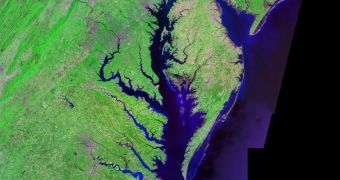A group of investigators with the United States Geological Survey (USGS) says that a large body of water submerged under the Chesapeake Bay may be all that remained from an ancient sea that existed in this region hundreds of millions of years ago.
The group identified a mass of high-salinity groundwater buried no less than 1 kilometer (0.6 miles) under the Bay. Upon analyzing it, researchers determined that it most likely originated within the North Atlantic Sea, which began developing in the early Cretaceous period.
This is about the same time when the last age of the dinosaurs began. Measurements conducted by the USGS team reveals that the ancient sea occupied this area of the US East Cost sometime between 100 and 145 million years ago.
The team was able to reveal that the submerged water is nearly twice as salty as modern-day surface waters. Experts were able to investigate these vestigial remains because the ancient water was preserved in the ground like an insect in tree resin.
This was made possible, the team says, by a massive asteroid impact, which occurred in the area roughly 35 million years ago. “Previous evidence for temperature and salinity levels of geologic-era oceans around the globe have been estimated indirectly from various types of evidence in deep sediment cores,” team member Ward Sanford explains.
“In contrast, our study identifies ancient seawater that remains in place in its geologic setting, enabling us to provide a direct estimate of its age and salinity,” adds the investigator, the lead author of the new study, and a research hydrologist at the USGS.
The team goes on to say that the Chesapeake Bay impact crater is one of only a handful of craters ever identified, documented and studied on the ocean floor worldwide. As such, the conclusions of the new study are very important for understanding this class of impacts.
“Various theories related to the crater impact have been developed to explain the origin of this high salinity. But, up to this point, no one thought that this was North Atlantic Ocean water that had essentially been in place for about 100 million years,” adds expert Jerad Bales.
Bales is the acting associate director for water at the USGS. Details of the new research were published in the November 14 issue of the top scientific journal Nature.

 14 DAY TRIAL //
14 DAY TRIAL //